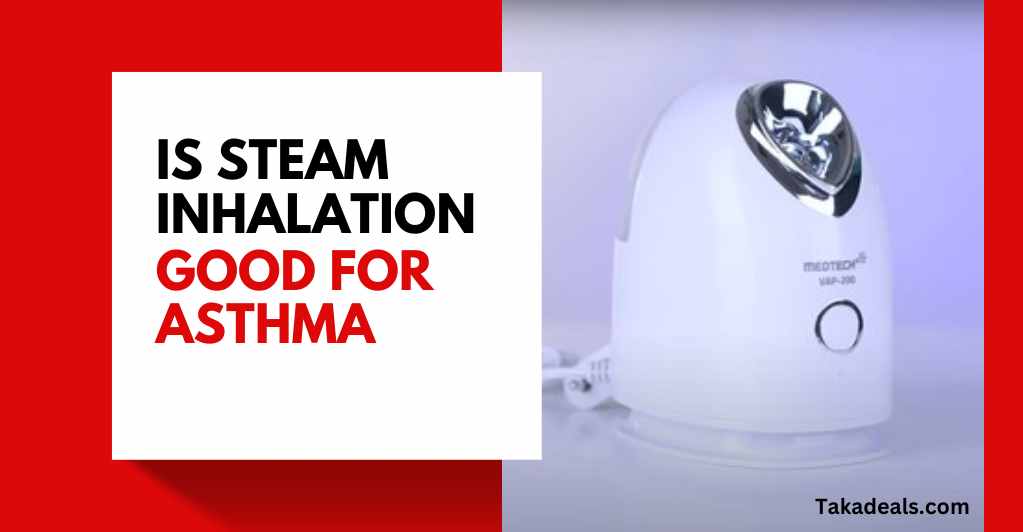
Is Steam Inhalation Good for Asthma?
Is Steam Inhalation Good for Asthma? According to various studies and observations made, it is stated that millions of people around the world are suffering from asthma disease. Also, there are thousands of deaths reported just because of asthma.
Well, it is true that asthma attacks are so frightening and can be fatal as well. As there is no medication available that can completely cure asthma, healthcare experts prescribe inhalers and medications for asthma management.
When having medical treatment, you are also needed to avoid all the potential triggers. The potential situations can also be controlled by keeping asthma inhalers handy every time. Nevertheless, there are some home remedies that people can opt for as an additional treatment for their deteriorating asthma.
Various asthma management tricks can keep the condition in control. Steam inhaling is a suggested treatment that is somewhere helpful in eliminating the symptoms and potential risk of asthma. Let us check out the following article to know if Is Steam Inhalation Good for Asthma or not.
Overview Of Asthma
Asthma can be simply considered to be a chronic issue in which the lungs are inflamed and the airways get narrowed. It results in recurring episodes of wheezing, chest tightness, coughing, and breathing shortness. Triggers like allergens, smoke, or exercise can provoke symptoms.
Treatment includes inhalers and medications to manage inflammation and open airways, enabling individuals to control and alleviate symptoms for better lung function and overall well-being. Also, healthcare experts suggest staying less active in case your asthma is severe.
Asthma Management Tips (Is Steam Inhalation Good for Asthma)

There are so many ways other than medications that can help you to manage your asthma effectively. Here are some of the asthma management tips mentioned that you can take help from:
- Consult a Healthcare Professional: It is a good idea to visit your doctor periodically and ask for updates on the status of your therapy.
- Understand Triggers: Identify and avoid triggers that worsen your symptoms including smoke, dirt, dust, etc.
- Proper Medications: Use inhalers and medications as directed by your doctor, even when symptoms are absent.
- Monitor Symptoms: Keep track of symptoms and peak flow readings to notice changes early.
- Know Peak Flow Zones: Learn your personal peak flow zones (green, yellow, red) to gauge your asthma control.
- Stay Active: Engage in regular exercise, but consult your doctor about appropriate activities.
- Maintain a Healthy Lifestyle: You must control stress, maintain a healthy diet, and have regular sleeping patterns. Also, you would have to stop smoking.
- Keep Rescue Inhaler Handy: Always have your quick-relief inhaler with you in case of sudden symptoms.
- Vaccinations: Stay up-to-date on vaccinations, including flu and pneumonia shots.
- Proper Inhaler Technique: Learn and practice correct inhaler techniques for optimal medication delivery.
- Travel Preparation: If you are traveling, pack extra medication and copies of your asthma action plan.
- Emergency Plan: Know when to seek emergency medical help and understand the steps to take.
- Stay Informed: Keep learning about new asthma treatments and management strategies.
- Home remedies: Though these are not scientifically proven, you can take the help of remedies like steam inhalation.
How Steam Can Alleviate Asthma?
Steam inhalation is often considered a home remedy for asthma relief. However, its effectiveness is debated among medical professionals. Breathing issues may be temporarily alleviated by the warm, moist air that comes from steam. However, it is important to remember that steam inhalation is not a replacement for medically prescribed asthma treatments and might not be suitable for everyone.
Excessive heat may have negative effects on some people and increase asthma symptoms in others. Consulting a healthcare provider before trying steam inhalation for asthma will be a great idea as you will be aware of its alignment with the treatment plans and medications.
Benefits of Steam Inhalation
Though there is a debate among healthcare experts considering the benefits of steam inhalation for asthma patients, there are some potential benefits that you might observe. Here are some of them:
- Lubrication: The thick and resistant mucus that lines the passages in the lungs is liquefied when the steam is discharged. This eventually lets you have improved breathing, which may ultimately return to a normal lifestyle.
- Boosts Immune system: When steam is taken, it helps to fight harmful viruses and germs making your lungs and immunity system even stronger.
- Reduces Inflammation: The lack of moisture and sinuses in the airways increases during a severe asthma attack. Using a steam inhaler for loosening the sputum ensures that the inflammation will be treated.
- Relieves Stress: Asthma can easily get triggered by stress and anxiety. It’s crucial to maintain control over both. Steam inhalers will soothe your mind and give you relaxation. The more relief you will get from stress and anxiety, the less you are susceptible to asthma attacks.
- Enhanced Circulation: When you boost circulation, you decrease inflammation and vasoconstriction which is the narrowing of blood vessels, which aids in the opening of the bronchial tubes. Your entire wellness profile continues to take advantage of having a good cardiovascular system.
Also Read: Do Asthma Inhalers Cause Weight Gain?
Steam Therapy At Home (Is Steam Inhalation Good for Asthma)
If you do not want to go with the steam inhaler devices then you can opt for steam therapy at home. This therapy is extremely simple and can be done in just some minutes. Here are the actions you must take to achieve a successful outcome.
Step 1. First of all, you will need to find a comfortable place that is quiet enough for performing the steam therapy safely.
Step 2. In this step, you have to boil the water in a pot or bowl properly. When it is boiled, cool down the bowl for avoiding any burns.
Step 3. This is completely an optional step that you might opt for. Do consider a doctor’s consultation before using any type of herbs. You may add eucalyptus or chamomile to the bowl so that you can get better soothing steam.
Step 4. Put the boiling water pot on an even surface. Bend over the pot while erecting a tent out of a blanket or towel to catch vapor. To prevent yourself from burning, ensure that the shelter is not very close to you.
Step 5. Breathe slowly and deeply through the nostrils as you inhale the steam. Take care not to breathe in rapidly or forcefully because this may harm the air passages.
Step 6. The steam inhale must be around five to ten minutes at the initial stage. If you feel any discomfort then immediately stop the process.
Step 7. You can also use a humidifier. Maintaining moisture in the environment through the installation of a device that humidifies your space may also be advantageous for your respiratory health.
Step 8. It is important to keep in mind that not everyone should try steaming therapy, particularly if they have chronic asthma or another respiratory ailment. Before starting any new therapies, always have a consultation with your doctor.
What Qualities Should A Steam Inhaler Have?
Due to the advancement in technology, modern steam inhalers come in a huge variety. From breathing masks styled inhalers to those manufactured using essential oils, there is a diverse range of steam inhalers available in the market.
Also, if you look for more advanced inhalers then you will also get features like temperature control and other adjustments. However, the following are some fundamental considerations that you should bear in mind:
- Lightweight: Make sure the inhaler must be lightweight which means you can easily hold it. Also, it must include easy functionality.
- Portable: If you are a frequent traveler then the steam inhaler you are choosing must be portable as well. This can help you to have an easy and effortless traveling experience.
- Durable: The design and materials of the inhaler must be sturdy. This is so important in order to have safe and durable usage.
Also Read: What Is The Difference Between PhotoStick and PhotoStick Mobile?
FAQs: Is Steam Inhalation Good for Asthma?
Q1. Is It Not Good To Have Steam Inhalation?
Ans. If you are using moderate hot water then it is fine to continue with steam inhalation. You should avoid using extremely hot water as it could be bad for the health of your lungs.
Q2. How To Make The Asthma Lungs Stronger?
Ans. There are numerous advantages to being active for those who have asthma, and exercise is crucial for lung and general health. Daily activity increases your body’s maximal oxygen consumption as well as the overall capacity of your lungs.
Q3. Can An Air Purifier Help with Asthma?
Ans. Certainly, the air purifier does help in eliminating the symptoms of asthma. As you know that air pollution and asthma are linked, and having an air purifier installed can eliminate the potential risk of asthma attacks.
Wrapping Up – Is Steam Inhalation Good for Asthma?
To conclude, you can say that steam inhalation may provide temporary relief by easing congestion in asthma, but it will not be effective in addressing the underlying inflammation or bronchoconstriction. Its effectiveness is debated, and potential risks like triggering symptoms or burns also exist.
Asthma management relies on prescribed medications and professional guidance, making steam inhalation an adjunct rather than primary therapy. Consulting healthcare providers before trying it is vital for comprehensive asthma care. Apart from that, have proper precautions while performing steam therapy. If you witness any issues or triggers in asthma, immediately stop practicing steam inhalation Is Steam Inhalation Good for Asthma?






